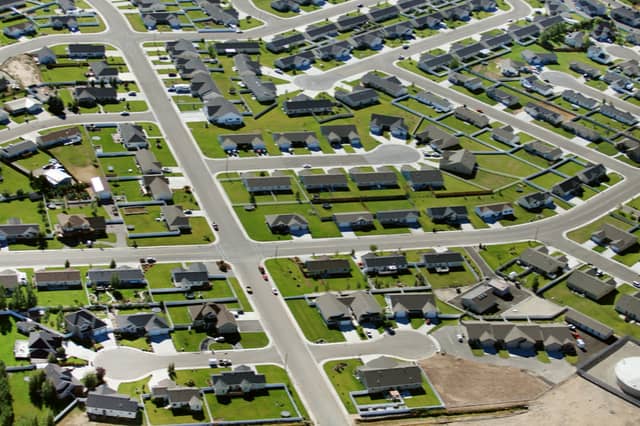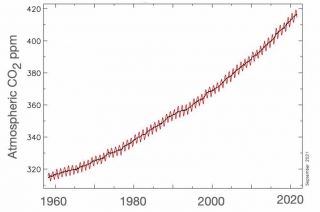
www.buildingsandcities.org/insights/commentaries/cop26-carbon-dependency.html
Unlock Carbon Dependency: Integrate Low-Carbon Development and Territorial Justice

By Stefan Siedentop (ILS - Research Institute for Regional and Urban Development & TU Dortmund University, DE)
Considerable institutional, technological and social lock-in inhibits the needed transition to a climate-friendly society. To overcome this, the socio-spatial effects of climate action must be on an equal basis with mitigation efficacy. Overcoming carbon lock-in in the built environment is much more than a technical issue; it will require the synergy of social, environmental and territorial justice.
The IPCC's Sixth Assessment Report, which was published in August 2021, sends a clear, unequivocal message: only a radical reduction of CO2 and other GHG emissions can prevent global warming of more than 1.5 or 2.0 oC (IPCC 2021). Because of past climate policy failures, the reduction pathway is now particularly steep. Achieving the 1.5 oC target requires climate neutrality by 2050 at the latest, which implies annual emissions reductions of approximately 7 to 8% (UNEP 2019). This need confronts policy-makers with unprecedented challenges.
In the fields of architecture, construction, and urban planning, research has described the pathways toward a low-carbon future for many years. Examples include urban intensification, decentralized energy systems, transit-oriented development or energy-efficient improvements of building stocks. However, there is disillusionment with regard to the implementation of such concepts. The decarbonization of urban systems is still more of a distant utopia than a tangible future. Against this background, it is no longer enough to ask what needs to be done to achieve climate neutrality. Even more important is the question of why we are not doing what we should be doing. In the coming years, politics and society will have to deal more systematically with the institutional, technological and social barriers to the effective implementation of climate protection policies.
In recent years, science has attempted to provide comprehensive answers to this question. One approach that has received much attention is 'carbon lock-in', which addresses a strongly path-dependent 'captivity' in fossil technologies and the corresponding infrastructures, institutions, behaviour patterns, and discourses (Unruh 2000; Seto et al. 2016; Buschmann & Oels 2019). Carbon lock-in explains the failure of or delay in the adoption of low-carbon technologies and behaviours by the entrenchment of tightly interwoven social norms, institutions (such as regulations and subsidies), and robust routines in the application of a carbon-based technology.
The much-debated phenomenon of urban sprawl can serve as a perfect example; suburban built environments are the result of countless location decisions that are undertaken by households and firms with the promise of permanently low energy costs made possible by enormous public infrastructure investments. Over time, 'pro-sprawl' political, market, and social factors have been reinforced, thereby making it difficult to move away from this structure and the lifestyles intertwined with it. Suburbia, as we know it today, implies a high dependence on motorized transport and high energy and infrastructure expenditures, all of which substantially reduces the political options for 'breaking out' of this "techno-institutional complex" (Unruh 2000).
Previous policies that have aimed to promote more climate-friendly urban development have also been relatively unsuccessful because they can be easily de-legitimized with respect to their assumed uneven social outcomes. In recent years, urban transformation agendas have repeatedly been confronted with accusations of leading to a disproportionate burden on low-income households. References have been made to processes of gentrification and displacement in upgraded urban neighbourhoods (Checker 2011), the disproportionate burden of renewable energy production on rural regions, and the disadvantage of the suburban and rural population due to higher energy costs. Frames such as 'jobs versus environment', 'urban against rural' or 'sustainable for whom?' have been quite successful in undermining broader political support for a climate-friendly transformation policy.
It was not until recently that CO2 avoidance costs were recognized as being unequally distributed both socially and spatially. A sort of double disadvantage has thus become discernible; i.e., lower-income segments of the population were and are disproportionately affected by the burdens of the fossil energy and transport industries as well as climate change effects (reference is here made to the discourse on "environmental justice" and "climate justice", see Farrell 2016 and Klinsky & Mavrogianni 2020). At the same time, they are again disproportionately affected in the phase of replacing fossils with regenerative technologies through mechanisms of the labour market, energy and transport markets (Evans & Phelan 2016).
Against this background, the evaluation of climate policies must equally consider both efficacy and the distributional effects found across the social stratification structure and along the urban-rural gradient. The societal costs of environmental change must be safeguarded and shared fairly. Here, the discourse on 'just transition' can be taken up (Mc Cauley & Heffron 2018; Evans & Phelan 2016; Farrell 2016).
This also has a spatial dimension, which is the central point of this essay. We need to consider more the socio-spatial effects of climate action in the design of policies and programs of action. What is needed are compensation mechanisms that avoid social hardship. Such mechanisms must be implemented at the micro level, for example, in tax, levy, labour market and social policies. However, place-based approaches are also needed to facilitate climate- and socially-compatible adaptation pathways in suburban and rural regions, as well as access to meaningful public participation. In short, breaking out of the carbon lock-in requires the synergy of social, environmental and territorial justice.
References
Buschmann, P., Oels, A. (2019). The overlooked role of discourse in breaking carbon lock-in: The case of the German energy transition. WIREs Climate Change, 10, 1-14. https://doi.org/10.1002/wcc.574
Checker, M. (2011). Wiped out by the "Greenwave": environmental gentrification and the paradoxical politics of urban sustainability. City & Society, 23, 210-229. https://doi.org/10.1111/j.1548-744X.2011.01063.x
Evans, G., Phelan, L. (2016). Transition to a post-carbon society: linking environmental justice and just transition discourses. Energy Policy, 99, 329-339. https://doi.org/10.1016/j.enpol.2016.05.003
Farrell, C. (2016). A just transition: Lessons learned from the environmental justice movement. Duke Forum for Law & Social Change, 4, 45-63. https://scholarship.law.duke.edu/dflsc/vol4/iss1/3
IPCC (2021). Summary for Policymakers. In: Climate Change 2021: The Physical Science Basis. Contribution of Working Group I to the Sixth Assessment Report of the Intergovernmental Panel on Climate Change. Cambridge University Press.
Klinsky, S., & Mavrogianni, A. (2020). Climate justice and the built environment. Buildings and Cities, 1(1), 412-428. https://doi.org/10.5334/bc.65
McCauley, D., Heffron, R. (2018). Just transition: Integrating climate, energy and environmental justice. Energy Policy, 119, 1-7. https://doi.org/10.1016/j.enpol.2018.04.014
Seto, K.C., Davis, S.J., Mitchell, R.B., Stokes, E.C., Unruh, G.C., Ürge-Vorsatz, D. (2016). Carbon lock-In: Types, causes, and policy implications. Annual Review of Environment and Resources, 41, 425-452. https://doi.org/10.1146/annurev-environ-110615-085934
UNEP. (2019). Emissions Gap Report 2019. Executive summary. Nairobi: United Nations Environment Programme.
Unruh, G.C. (2000). Understanding carbon lock-in. Energy Policy, 28, 817-830. https://doi.org/10.1016/S0301-4215(00)00070-7
Latest Peer-Reviewed Journal Content
Acceptability of sufficiency consumption policies by Finnish households
E Nuorivaara & S Ahvenharju
Key factors for revitalising heritage buildings through adaptive reuse
É Savoie, J P Sapinski & A-M Laroche
Cooler streets for a cycleable city: assessing policy alignment
C Tang & J Bush
Understanding the embodied carbon credentials of modern methods of construction
R O'Hegarty, A McCarthy, J O'Hagan, T Thanapornpakornsin, S Raffoul & O Kinnane
The changing typology of urban apartment buildings in Aurinkolahti
S Meriläinen & A Tervo
Embodied climate impacts in urban development: a neighbourhood case study
S Sjökvist, N Francart, M Balouktsi & H Birgisdottir
Environmental effects of urban wind energy harvesting: a review
I Tsionas, M laguno-Munitxa & A Stephan
Office environment and employee differences by company health management certification
S Arata, M Sugiuchi, T Ikaga, Y Shiraishi, T Hayashi, S Ando & S Kawakubo
Spatiotemporal evaluation of embodied carbon in urban residential development
I Talvitie, A Amiri & S Junnila
Energy sufficiency in buildings and cities: current research, future directions [editorial]
M Sahakian, T Fawcett & S Darby
Sufficiency, consumption patterns and limits: a survey of French households
J Bouillet & C Grandclément
Health inequalities and indoor environments: research challenges and priorities [editorial]
M Ucci & A Mavrogianni
Operationalising energy sufficiency for low-carbon built environments in urbanising India
A B Lall & G Sethi
Promoting practices of sufficiency: reprogramming resource-intensive material arrangements
T H Christensen, L K Aagaard, A K Juvik, C Samson & K Gram-Hanssen
Culture change in the UK construction industry: an anthropological perspective
I Tellam
Are people willing to share living space? Household preferences in Finland
E Ruokamo, E Kylkilahti, M Lettenmeier & A Toppinen
Towards urban LCA: examining densification alternatives for a residential neighbourhood
M Moisio, E Salmio, T Kaasalainen, S Huuhka, A Räsänen, J Lahdensivu, M Leppänen & P Kuula
A population-level framework to estimate unequal exposure to indoor heat and air pollution
R Cole, C H Simpson, L Ferguson, P Symonds, J Taylor, C Heaviside, P Murage, H L Macintyre, S Hajat, A Mavrogianni & M Davies
Finnish glazed balconies: residents' experience, wellbeing and use
L Jegard, R Castaño-Rosa, S Kilpeläinen & S Pelsmakers
Modelling Nigerian residential dwellings: bottom-up approach and scenario analysis
C C Nwagwu, S Akin & E G Hertwich
Mapping municipal land policies: applications of flexible zoning for densification
V Götze, J-D Gerber & M Jehling
Energy sufficiency and recognition justice: a study of household consumption
A Guilbert
Linking housing, socio-demographic, environmental and mental health data at scale
P Symonds, C H Simpson, G Petrou, L Ferguson, A Mavrogianni & M Davies
Measuring health inequities due to housing characteristics
K Govertsen & M Kane
Provide or prevent? Exploring sufficiency imaginaries within Danish systems of provision
L K Aagaard & T H Christensen
Imagining sufficiency through collective changes as satisfiers
O Moynat & M Sahakian
US urban land-use reform: a strategy for energy sufficiency
Z M Subin, J Lombardi, R Muralidharan, J Korn, J Malik, T Pullen, M Wei & T Hong
Mapping supply chains for energy retrofit
F Wade & Y Han
Operationalising building-related energy sufficiency measures in SMEs
I Fouiteh, J D Cabrera Santelices, A Susini & M K Patel
Promoting neighbourhood sharing: infrastructures of convenience and community
A Huber, H Heinrichs & M Jaeger-Erben
New insights into thermal comfort sufficiency in dwellings
G van Moeseke, D de Grave, A Anciaux, J Sobczak & G Wallenborn
'Rightsize': a housing design game for spatial and energy sufficiency
P Graham, P Nourian, E Warwick & M Gath-Morad
Implementing housing policies for a sufficient lifestyle
M Bagheri, L Roth, L Siebke, C Rohde & H-J Linke
The jobs of climate adaptation
T Denham, L Rickards & O Ajulo
Structural barriers to sufficiency: the contribution of research on elites
M Koch, K Emilsson, J Lee & H Johansson
Disrupting the imaginaries of urban action to deliver just adaptation [editorial]
V Castán-Broto, M Olazabal & G Ziervogel
Nature for resilience reconfigured: global- to-local translation of frames in Africa
K Rochell, H Bulkeley & H Runhaar
How hegemonic discourses of sustainability influence urban climate action
V Castán Broto, L Westman & P Huang
Fabric first: is it still the right approach?
N Eyre, T Fawcett, M Topouzi, G Killip, T Oreszczyn, K Jenkinson & J Rosenow
Social value of the built environment [editorial]
F Samuel & K Watson
Understanding demolition [editorial]
S Huuhka
Data politics in the built environment [editorial]
A Karvonen & T Hargreaves



Latest Commentaries
Decolonising Cities: The Role of Street Naming
During colonialisation, street names were drawn from historical and societal contexts of the colonisers. Street nomenclature deployed by colonial administrators has a role in legitimising historical narratives and decentring local languages, cultures and heritage. Buyana Kareem examines street renaming as an important element of decolonisation.
Integrating Nature into Cities
Increasing vegetation and green and blue spaces in cities can support both climate change mitigation and adaptation goals, while also enhancing biodiversity and ecological health. Maibritt Pedersen Zari (Auckland University of Technology) explains why nature-based solutions (NbS) must be a vital part of urban planning and design.